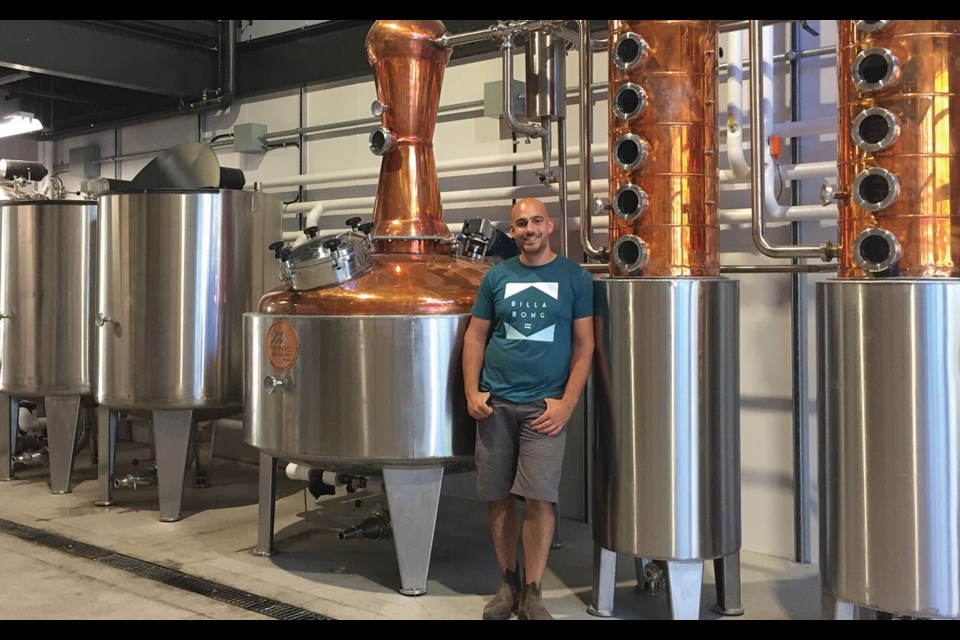When I finally catch up to Dominic Griffin, he's the kind of busy that only a one-man operation can make you: up a ladder, phone to ear, monitoring the contents of a large steel mash tank draining through a hose into a similar-sized fermentation vessel. Nevertheless, he doesn't miss a beat in explaining what he's doing.
Hours earlier, he'd ground up some Canadian grain, dumped it into the tank (mash tun in distillation argot), filled the vat with water heated to about 70C, and let it sit for an hour. In that short spell the water extracted all-important sugars from the grain, rendering the sweet liquid now flashing through the hose. Griffin had hoped for two batches of mash today but the grain arrived late and so did he. Still, his accomplishment seems efficient by any standards. And the next stage? "I'm playing with different yeasts," says the tanned, easygoing Griffin over his shoulder, "so the fermentations can be anywhere from seven to 10 days."
While waiting for the mash tun to render, he kept busy running the results of a previous fermentation through the front end of the distillation system in a step called stripping, which takes the beery concoction of around nine per cent alcohol up to 30 per cent; several fermentation batches are stripped then stored in a square steel box known as a safe.
A safe? "Something about whisky makers in Ireland having to lock up the distilled spirit at night so workers didn't dip into it," offers Griffin.
For a final act, the liquid will go into a pot distiller then through a series of polished copper distillation columns that look like something out of the industrial 19th century—which they very much are, being basically unchanged since their invention by French-born Irishman Aeneas Coffey in 1830. A stripping run averages 10 hours, distillation around 12.
Distilling configurations are custom built to fit spaces, in this case the Function Junction location of Montis Distillery, a logical libation addition to Whistler's three breweries, two of which are neighbours. Montis is Latin for mountain, a more sophisticated take on the local trend of too-obvious business names.
The backstory starts with Griffin's partner, Kwang Chen. A hobby distiller with a passion for spirits, Chen originally looked to produce bourbon. But making whisky that sits around in barrels for years means bankrolling it; Chen decided to first make vodka and gin, which don't require ageing. Griffin, who has a background making beer but runs a Vancouver business doing custom furniture and renovations, originally met Chen through a furnishing job at the latter's home. They got chatting, and when Chen decided on a distillery two years ago he hired Griffin to help build it.
"When it was almost done he asked if I was interested in partnering on running the place. I said yes. Between us we felt pretty confident on giving it a go," says Griffin, who clearly has everything running and no problem running it—constantly buzzing phone included. "Craft beer has become huge in B.C., but distilleries are nowhere near that level so the market's pretty open. Vancouver has over 100 breweries but only a handful of distilleries."
Above us, a cozy loft features leather chairs and a few shelves of bottles. Here they'll run private functions and store whisky barrels—including small ones for pre-pay customers who'll eventually help bottle it. An on-site tasting room may necessitate changes to the upstairs configuration, but as other Function operators know, parking is still an issue. In the meantime, the goal is restaurants (Montis is in Il Caminetto and Bearfoot Bistro), farmer's markets and retail outlets up and down the corridor. Once there's a good store of product they'll start pushing sales, but for now it's all about getting product. Mash. Ferment. Strip. Distill.
The final distillate is a 95 per cent neutral spirit, starting point for both vodka and gin. "To make vodka we just proof the spirit down to 40 per cent with glacier water from Rainbow Mountain. Gin goes back into the pot still and a phase of filtering through botanicals in vapour form. When it's re-condensed I'll proof it down to about 45 per cent."
Vodka and gin—their labels as clean and distinct as the spirits themselves—are already for sale on site, though it's not yet open regular hours. I like the gin's mix of classic botanicals—juniper, dried orange peel, black cardamom, coriander, ginger—and a whiff of Montis' signature cedar.
Getting this mix right requires experimenting, accomplished in a small, single distillation column tucked under the stairs that can also be used for custom gin-making for restaurants or private events like weddings.
End to end from grain to bottle takes about 12 days, says Griffin. Though it takes five to six weeks of multiple runs to fill the safe, which will yield 500 to 600 bottles.
Griffin finally has to answer his phone. I sit back in front of the pot still. The distillery doors are open front and back, the funk of boiled grain hitting me when the wind comes from the rear, alcohol wafting from the safe when a zephyr comes the other way. All in all, it smells like a good idea.
Leslie Anthony has never had a real job—which is why he writes about them. Would yours make a good story? Let him know at docleslie@me.com.




